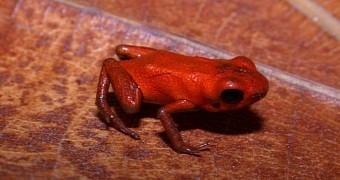A recent paper in the journal Zootaxa announced the discovery of a previously undocumented poison dart frog species. These amphibians live in Panama. Given their body color, it really is a wonder it took scientists this long to document their existence.
Thus, as shown in the photo accompanying this article, these newly discovered poison dart frogs in Panama are bright orange. As if this weren't enough to make them stand out, researchers say that they produce a unique call.
Documenting a new species
Writing in the journal Zootaxa, scientists with Panama's Smithsonian Tropical Research Institute and Universidad Autónoma de Chiriquí, together with researchers at Colombia's Universidad de los Andes, say that this species was identified with the help of just one frog.
The specimen in question was caught in the headwaters of the Rio Caño in the district of Donoso in Panama's Colón Province quite a while ago, in February 2011. It was captured by researchers Samuel Valdés and Carlos de la Cruz.
In the years to come, other amphibians belonging to the same species, now known as Andinobates geminisae, were found in natural ecosystems birthed by Panama's Rio Coclé del Norte and the Rio Belen. Having studied these specimens, researchers concluded that they were representatives of a new species.
Interestingly enough, specialists first assumed that what they were dealing with was not a previously undocumented species, but with an already studied one dubbed Oophaga pumilio. This is because Oophaga pumilio specimens can look quite differently from one another.
“Abel Batista and Marcos Ponce were the first to note the presence of this species. They’ve known it was there for several years. However, they were not sure if it was only a variety of another poison dart frog species, Oophaga pumilio, which exhibits tremendous color variation,” explains specialist Cesar Jaramillo.
It was only when they collected enough specimens to be able to put together a genetic profile of these amphibians that scientists figured out that the bright orange amphibians found in Panama belonged to an entirely new species.
This new species is already in trouble
Despite the fact that the scientific community has just been made aware of their existence, these bright orange poison dart frogs are already in trouble. Thus, researchers say that very few of them appear to be left in the wild, and that the species might go extinct in the not-too-distant future.
By the looks of it, habitat loss and the flourishing pet trade are the chief threat to these creatures' long-term survival. Looking to keep the species from falling off the biodiversity map, specialists recommend that several such frogs be entered into captive breeding programs, and that efforts be made to safeguard their natural habitat.

 14 DAY TRIAL //
14 DAY TRIAL //